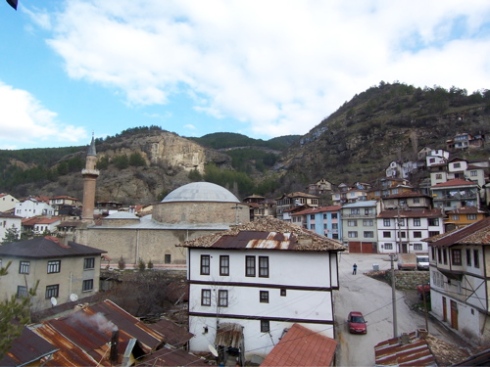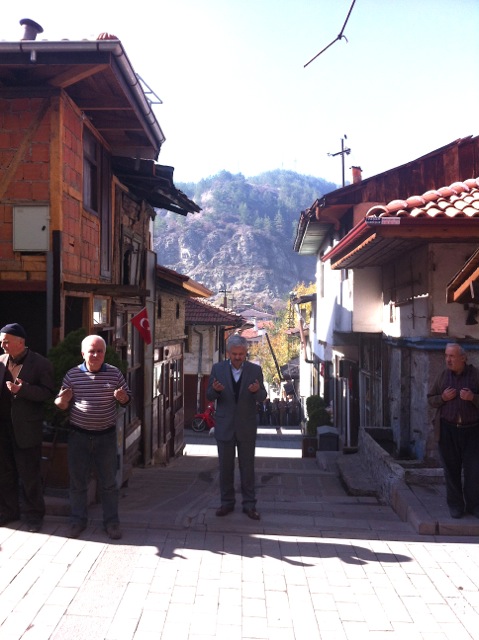From time to time we ask heritage practitioners to share their stories. Placing them on our blog is not an endorsement of their work or underlying paradigm. Here, heritage planner Dr. Ayse Ege YILDIRIM of Koc University, Istanbul shares a case study about A Cultural Heritage Management Plan for Mudurnu, Turkey.
By Dr. A. Ege YILDIRIM
Heritage Planner, J.M. Kaplan Senior Fellow for Archaeological Site Management, Research Center for Anatolian Civilizations (RCAC), Koç University, Istanbul
While Turkey has a great wealth of cultural heritage sources and quite an established legal and institutional tradition of their conservation, the country is now witnessing a new paradigm in the national sphere of historic preservation, namely that of site management. High-profile, often World Heritage sites like the historical areas of Istanbul or the neolithic site of Çatalhöyük have been the focus of site management plans in recent years, but sites that are of more modest scale but spread throughout the country in greater numbers, also warrant attention in terms of site management, both as prescribed in current national legislation and by nature of their own characteristics and needs.
The historic Silk Road town of Mudurnu, in the northwestern Anatolian province of Bolu, is one such modest but significant site. In my doctoral research (2008-11) examining governance in urban conservation projects, I had observed some noteworthy instances of collaboration between stakeholders for the conservation of the town’s cultural resources, and I returned to Mudurnu this year as part of my research fellowship for site management at the Research Center for Anatolian Civilizations (RCAC) of Koç University. The research project, to create a Cultural Heritage Management Plan For Mudurnu, aims to contribute to the nascent literature of cases where site management legislation is applied in Turkey and to produce a tangible project that will assist a small municipality in realizing their aspirations for sustainable tourism and development.
Mudurnu: A remarkable history and a wealth of heritage assets
Mudurnu, with a population of around 5,200, lies along its namesake river and forms part of the Sakarya Basin, along with other similar towns situated along the historic Silk Road. Known in antiquity as Bithynia, the region around Mudurnu holds traces of the Hittite, Phrygian, Lydian, Persian, Roman, Byzantine, Seljukid and Ottoman cultures. The first settlement of the town itself is known to have been around the citadel built in the name of Moderna, daughter of the local Byzantine governor. Mudurnu became a major Ottoman trading and crafts center, owing to its strategic location along trade routes, which has left a rich legacy of traditional timber-frame residential architecture. This dense fabric forms a powerful ensemble together with the town’s natural setting by a rocky river valley. Beside the Byzantine citadel, the monumental architecture of Mudurnu features Ottoman works such as the Yildirim Beyazit Mosque and Baths; Sultan Suleyman Mosque, the 288-shop Bazaar (‘Arasta’), the hill-top Clock Tower and numerous tombs for dervish saints. Complementing the built heritage is a strong intangible heritage element, reflected in the strong tradition of commerce dating back to the 13th century and still surviving through the guild culture (‘Ahilik’), in the various artisanal crafts and cuisine of the region, in the proud role Mudurnu played in the Turkish War of Independence of 1919-20, and in the famous son of Mudurnu, Pertev Naili Boratav, ethnologist and founder/ director of the Turkish Studies centers in Stanford and Paris-Sorbonne Universities. Furthermore, the town is surrounded by a range of natural heritage assets, including thermal springs and lakes, a popular holiday destination among them being Lake Abant. Almost the entire existing settlement area is designated as an urban conservation site, with 215 designated historic buildings, and a Conservation Plan was prepared in the mid-1990s, adding another 138 buildings to be protected by zoning.
Despite its rich array of heritage assets, Mudurnu’s livelihood and modern-day reputation have been founded on the poultry industry, led by Mudurnu Tavukçuluk, an easily recognized brand name in the Turkish retail market. The predominantly mountainous, woodland terrain of Mudurnu district has supported the traditional economic sectors of agriculture, animal husbandry and forestry, while tourism has not been as prominent. Things changed for Mudurnu with Turkey’s economic crisis of 2001, which dealt a blow to the poultry industry, causing a stream of emigration and a deep sense of loss in the community.
Efforts for Revitalization in Mudurnu since 2003
Efforts to find a way out of this state of affairs were soon begun, and around 2003, under the leadership of mayor Mehmet Karakasoglu, a new initiative to revive the economy through cultural and eco-tourism, sought in a way to ‘reinvent’ Mudurnu’s identity. First, local stakeholders came together for the 3T Project, based on tourism, textile and agriculture (‘tarim’), and then focused on the ‘Project for Tourism-based Revitalization of Traditional Architecture’, featuring restoration and adaptive reuse of some 30 historic houses, rehabilitation of several streets and the historic Arasta and some public realm improvements. This latter project, which won an award from the Turkish Union of Historic Towns (TKB), had a strong governance aspect, involving coordination between the Municipality, Bolu Province Directorate for Culture & Tourism, the Ministry of Culture & Tourism and local homeowners. Concerted local efforts were continued under mayor Mehmet İnegol, with the Mudurnu Workshop organized by the Bolu AIB University in 2010, and the creation in 2011 of the Silk Road Tourism Development Union formed by municipalities of the region, which is currently developing a Silk Road Tourism Corridor Action Plan. Other recent initiatives for culture and nature tourism have been an agro-tourism training program funded by the East Marmara Development Agency, the creation of an archeological park displaying classical era artefacts, a City Museum displaying ethnological features and early 20th century photographs, and the P.N. Boratav Culture House converted from the old district governor’s office. Beside these sustainable tourism projects, other noteworthy investments in Mudurnu have been the Sarot thermal resort 30 km north of the town and the housing units of TOKİ (Turkish Mass Housing Administration) southwest of the existing settlement.
As one can see above, substantial efforts have been made in the past decade to channel Mudurnu’s heritage assets into economic development by way of cultural tourism. As a result of historic mansion conversions and other hotels that started operating, Mudurnu has attained one of the highest levels of bed capacity within its region and is continuing to see increased visitor numbers, reaching more than 160,000 in 2012. However, a true breakthrough in sustainable tourism has not yet been truly achieved, and more remains to be done for the town and its district to adequately preserve its heritage assets and to fully realize its sustainable development potential. While the local officials cite insufficient financial resources and sponsors for projects, as well as a lack of motivation in the community, other risks to emerge may be the increasing tourism activity reaching a level that is hard to manage and damaging to Mudurnu’s environment and authentic character, and the migration of residents from historic homes to new housing and leaving the historic buildings to decay or change authentic functions.
Enter the Management Plan
This makes it an opportune time for well-planned heritage management practices in Mudurnu, which would go hand in hand with sustainable tourism strategies. An effective management plan could help mitigate risks such as cited above, bring together and coordinate all initiatives under one vision, facilitate information sharing, optimize economic resources, enable all stakeholders to take part in the process and create synergy toward a shared strategic vision.
This has been the context for the Mudurnu Cultural Heritage Management Plan, the goal of which can be summarized as ‘developing and implementing a strategy for sustainable development in Mudurnu that balances conservation and development, protects the town’s heritage resources and benefits the local community’.
As the key stakeholder in this process, Mudurnu Municipality and I have been working together since September 2013, with Mudurnu District Governorship (Kaymakamlık), Mudurnu Civic Council (Kent Konseyi) and the Mudurnu Culture, Tourism and Solidarity Association (MUKTUDER) having come on board as Project Partners. Since an essential condition for a successful site management plan is a strong culture of solidarity and cooperation, it appears we have caught a favorable wind in Mudurnu.
The Mudurnu Cultural Heritage Management Plan, following global best practice and national legislation and adapting their appropriate tools for the particular context of Mudurnu, strives to provide ‘a roadmap for how the site’s significance will be preserved together with stakeholders of the site’. Since its emergence in the latter part of the 20th century, site management is a method of strategic planning used mainly for protected areas, aimed at efficient use of resources, adapting to changing circumstances and more effectively reaching planning targets. The most important features of a management plan are recognized as a focus on ‘process’ rather than ‘end result’, and ‘participation’ of all stakeholders. Site management entered the Turkish legal sphere in 2004, after its importance was understood as a requirement of UNESCO World Heritage sites. The Turkish historic preservation law defines management plans as a method to be applied for all protected urban, archaeological and historical sites and their influence zones, with the coordination of official authorities and non-governmental organizations, comprising conservation and development projects, along with their yearly and five-yearly implementation phases and budgets, to be reviewed every five years. Accordingly, the major management planning phases for Mudurnu are formulated as:
- Establishing the Strategic Framework
- Identifying Project Partners and other stakeholders, holding information and consultation meetings
- Preparing the Draft Plan Report: Inventory of cultural assets of the site, site significance, appraisal of existing conditions, Plan Vision, Principles and Targets, Action Plans
- Completion and approval of Final Plan Report based on review by stakeholders
- Implementation process: Forming a permanent local team and an implementation- control mechanism, commencing the cycle of implementation, monitoring and plan revision
At this early stage of planning works, a key concern that emerges is for the plan to be viable, with sufficient stakeholder buy-in and financial resources for implementation. The first major milestone that would be achieved is the completion of the Plan Report as a tangible output. But the real measure of success will be when the Plan is put into action by a local team. In this regard, the local government elections coming up in three months is an important milestone that needs to be safely passed, as managerial continuity is often a risk to urban governance projects.
One way to overcome the funding question and ensure a solid foundation for the management plan could be taking it to a broader level. The ‘regional basin model’ advocated by the TKB can be taken as reference, and the Silk Road Tourism Development Union platform can be used to apply for funds of regional development agencies. Another dimension of the broad level approach would be to integrate the protection of cultural heritage with those of natural assets through eco-tourism. In this way, the cultural heritage management plan can become the initial step of a larger process.
It is our hope that the right answers to the above questions will be provided by the process itself as it moves forward. We believe that a sustainable development strategy that protects the town’s cultural identity while elevating its economic prosperity can be achieved with the support of the people of Mudurnu.
Mudurnu townscape with Yildirim Bayezit Mosque
Delegation visiting Haytalar Mansion, Mudurnu
The Fertility Prayer of the merchants, made on Friday mornings as per ‘Ahi’ guild tradition




